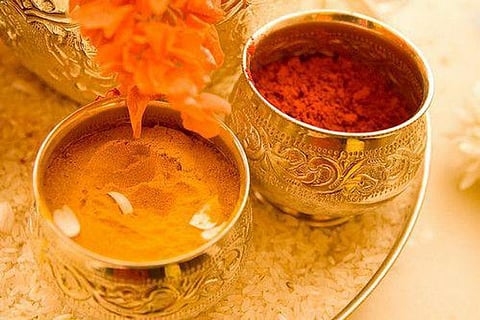The Significance of Sindoor and Turmeric in Hinduism: 8 Points That Will Explain it All!
Sindoor and turmeric are one of the key ingredients for most of the Hindu rituals or customs. What is interesting is that these materials have spiritual significance attached to them and therefore is very popular among Hindu devotees.
There are certain reasons that these materials are considered so holy in Hinduism:
Kumkum considered an essential material in Hinduism as it is a cultural identity of any married Hindu women. It forms an inseparable part of her life. Since ancient times, kumkum bindi on the forehead is a must for a married woman is prepared using turmeric and natural camphor.
Please Follow NewsGram on Facebook To Get Latest Updates!
In any religious ritual in Hinduism turmeric forms an important ingredient. Even turmeric is used for making the idols of Lord Ganesha for the Ganesh Pujan. Turmeric is not only of religious significance but has a medicinal value as well.
Being a natural antiseptic, it can be used to heal cuts and burns and also any internal health problems. Let's discuss in further details about these two ingredients:
Kumkum
Vermillion acts as a symbol for Hindu Married Women: From time immemorial, Hindu married women put vermilion on their forehead as a bindi and at the front of their middle-parted hair as tilak. This cultural identity reflects the desire of the longevity and success of one's husband.
Kumkum considered an essential material in Hinduism as it is a cultural identity of any married Hindu women. Pinterest
Turmeric Stands for Purification
The use of 'haldi' in any Hindu marriage must have grabbed everybody's attention. The paste of turmeric is applied to both bride and groom before their marriage. It stands for purifying both the bride and groom from all sins and prepares them for the auspicious wedding ceremony.
Kumkum Symbol of Female Energy
According to scholars, red is the colour of power and energy, and it stands for the power of Goddess Parvati or Sati who is the epitome of energy. Sati is the ideal wife as she dedicated her life to her husband, according to the Hindu mythology. Thus it is used as a legacy to show a woman's devotion towards her husband.
Turmeric Symbol of Many Things
Turmeric is the symbol of the sun, good luck and fertility in popular belief . It is a symbolism for the inner pride and overall prosperity of human beings. Thus it forms one of the key ingredients in any pious occasion.
Astrological Significance of Kumkum
Vermillion also stands as a symbol for 'saubhagya' or good luck, as per Hindu astrological beliefs. Actually, it is believed that the forehead is the place of the Mesha Rashi and Mars is the Lord of Mesha (Aries) Rashi. As it brings good luck to life, married women apply kumkum on the forehead.
Significance of colour in Turmeric
Turmeric is available in orange and yellow forms. It is surprising to believe that both these colours have their own significance. While yellow stands for chastity and sensuality, orange is the colour of the sun, courage and sacrifice.
The use of 'haldi' in any Hindu marriage must have grabbed everybody's attention. The paste of turmeric is applied to both bride and groom before their marriage. Pinterest
Mythical Significance of Kumkum
Every traditional item has to have its source in mythology similarly kumkum is no different and has its complete origin in mythology. Kumkum is made of turmeric and lead and is believed to boost up sexual drive. That's why married women apply kumkum, and it is prohibited for unmarried or widow women.
Significance of Turmeric on Your Health
Turmeric in warm milk is used as a relaxing agent. Not only that, but turmeric milk also heals any acid reflux or other pain in your body. Turmeric paste applied on skin brings a nice glow.
– by Saptaparni Goon. Twitter: @saptaparni_goon


